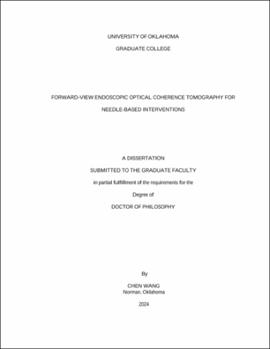| dc.description.abstract | Needle-based interventions (NBIs) are procedures that require a minimally invasive approach
to gain access to tissue structures of interest. Each year, more than 30 million of these
interventions are performed in the US. Due to the lack of proper visual feedback guiding
navigation, up to 33% of NBIs are associated with complications, incurring significant human
and economic costs. The objective of my dissertation is to establish a new research paradigm
shift in the methodology of NBIs through integrating a unique forward-imaging multi-contrast
optical coherent tomography (MC-OCT) needle technology with advanced machine-learning-
based computer-aided diagnosis algorithms. Optical coherence tomography (OCT) is a novel
biomedical imaging technique which provides micron-level spatial resolution. Compared to
conventional imaging modalities, it provides the imaging results with a lot more details of
localized tissue. OCT has been widely used in various applications including ophthalmology,
biopsy procedures, different disease diagnosis, etc. Furthermore, OCT can perform real-time
imaging based on the high-speed scanner and data acquisitor. Therefore, OCT has the
potential in real-time guidance in different NBIs. To successfully acquire depth-resolved
imaging during surgeries, we developed forward-view endoscopic OCT systems using
gradient-index (GRIN) lenses. Additionally, we utilized polarization-sensitive OCT (PS-OCT)
and Doppler OCT to build MC-OCT for enhanced tissue contrast and at-risk blood vessels
detection. PS-OCT is a function extension of traditional OCT because it provides
polarization-related biological features based on birefringence and diattenuation phenomena.
Doppler OCT is effective in fluid flow imaging, so we utilized it for blood flow detection. By
introducing PS-OCT and Doppler OCT, our endoscopic MC-OCT systems have been proved to be feasible in recognizing different tissue type and blood vessels. In this dissertation, we
demonstrated endoscopic MC-OCT systems in surgical navigations in different NBIs
including percutaneous nephrostomy (PCN), epidural anesthesia, Veress needle for
pneumoperitoneum establishment, and different cancer diagnosis. To improve the working
efficiency and reduce learning curves, we further applied deep learning methods in our studies
to automate the navigation procedures. Different architectures were tested for tissue
classifications and blood vessel detections. This innovated imaging platform has established a
paradigm shift, offering the potential for widespread applications across various NBIs. | en_US |
